warning light SKODA YETI 2010 1.G / 5L Manual Online
[x] Cancel search | Manufacturer: SKODA, Model Year: 2010, Model line: YETI, Model: SKODA YETI 2010 1.G / 5LPages: 271, PDF Size: 14.71 MB
Page 165 of 271

Intelligent Technology
164
offered must not tempt you to take greater risks than otherwise - risk of an acci-
dent!
Note
All four wheels must be fitted with the same tyres in order to achieve problem-free
operation of the ESP. Differing rolling circum ferences of the tyres can lead to an unde-
sirable reduction in the engine output.
Changes to vehicle (e.g. on engine, on th e brakes, on chassis or another combina-
tion of tyres and wheels) can influence the function of the ESP page 222, “Accesso-
ries, changes and replacement of parts”.
Electronic Differential Lock (EDL)*
The electronic differential lock prev ents an individual wheel from slip-
ping.Models fitted with ESP ar e equipped with electronic differential lock (EDL).
General
The EDL makes it much easier, and sometimes at all possible, to start off, accelerate
and climb a steep hill when the conditions of the road surface are unfavourable.
Operating principle
The EDL is activated automaticall y, that is without any action on the part of the driver.
It monitors the speeds of the driven wheels with the aid of the ABS sensors. Should
only one drive wheel begin spinning on a slippery surface there will be an appreciable
difference in the speed of the driven wheels. The EDL function brakes the slipping
wheel and the differential transmits a greate r driving force to the other driven wheel.
This control process is also accompanied by noises.
Overheating of the brakes
The EDL switches off automatica lly if unusually severe stresses exist in order to avoid
excessive heat generation in the disc brake on the wheel which is being braked. The
vehicle can continue to be driven and has the same characteristics as a vehicle not
fitted with EDL. The EDL switches on again automatically
as soon as the brake has cooled down.
EDL Off-road*
After switching on the Off-road mode page 170, EDL Off-road is activated.
EDL Off-road is matched in such a way that it assists the traction of the vehicle when
driving on an unfirm ground.
EDL is activated earlier in the Off-road mode than in the normal mode. The brake pres-
sure builts up more quickly on the slipping wheel, on one axle, as well as diagonally.
WARNING
Carefully depress the accelerator when accelerating on uniformly slippery
road surfaces, such as ice and snow. Th e driven wheels might still spin despite
the EDL and affect the stability of the vehicle - risk of an accident!
You should always adapt your style of driving to the condition of road
surface and to the traffic situation even when your vehicle is fitted with EDL.
The increased safety offered must not tempt you to take greater risks than
otherwise - risk of an accident!Note
If the ABS or ESP warning light comes on, this may also indicate a fault in the EDL.
Please have the vehicle inspected as soon as possible by a specialist garage.
Changes to vehicle (e.g. on engine, on the brakes, on chassis or another combina-
tion of tyres and wheels) can influence the function of the EDL page 222, “Accesso-
ries, changes and replacement of parts”.
WARNING (continued)
s2ug.6.book Page 164 Friday, April 9, 2010 2:24 PM
Page 166 of 271

Intelligent Technology165
Using the system
Safety
Driving Tips
General Maintenance
Breakdown assistance
Technical Data
Traction control system (TCS)
The traction control system prevents the driven wheels from spinning
when accelerating.General
The TCS makes it much easier, and sometimes at all possible, to start off, accelerate and
climb a steep hill when th e conditions of the road surface are unfavourable.
Operating principle
The TCS switches on automatically when th e engine is started and then conducts a
self-test. The system monitors the speeds of the driven wheels with the aid of the ABS
sensors. If the wheels are spinning, the force transmitted to the road surface is auto-
matically adapted by reducing the engine speed. The system operates at all speeds.
The TCS operates in combination with the ABS page 167, “Antilock brake system
(ABS)”. The TCS will not function if a fault exists in the ABS system.
The TCS warning light lights up in the instru ment cluster when there is a fault on the
TCS
page 33.
During an intervention of the system, the TCS warning light
flashes in the instru-
ment cluster page 33.
Switching off
You can switch the TCS off and on again as yo u wish. On vehicles fitted with ABS, you
can switch off the TCS by pressing the button fig. 147 , on vehicles fi tted with ESP*,
you can switch off the TCS wi th the aid of the button page 163, fig. 146 . The TCS warning light lights up in the instrument cluster when the system is switched off
page 33.
The TCS should normally always be switched on. It may be good practice in certain
exceptional cases, such as when you wish to have wheel slip, to switch off the system.
Examples:
when driving with snow chains
when driving in deep snow or on a loose surface
when it is necessary to rock a vehicle when it has become stuck.
then you should switch on the TCS again.
TCS Off-road*
After switching on the Off-road mode page 170, TCS Off-road is activated.
TCS Off-road provides a more effective a cceleration of the vehicle on an unfirm
ground, as it allows higher traction be tween the slipping wheels and the ground.
The system operates when starting off or at low speeds.
WARNING
You should always adjust your style of driving to the conditions of the road
surface and the traffic situation. The increased safety offered must not tempt
you to take greater risks than otherwise - risk of an accident!
Note
All four wheels must be fitted with the same tyres in order to achieve problem-free
operation of the TCS. Differing rolling circumferences of the tyres can lead to an unde-
sirable reduction in the engine output.
Changes to vehicle (e.g. on engine, on the brakes, on chassis or another combina-
tion of tyres and wheels) can influence the function of the TCS page 222, “Accesso-
ries, changes and replacement of parts”.
Fig. 147 TCS switch
s2ug.6.book Page 165 Friday, April 9, 2010 2:24 PM
Page 167 of 271
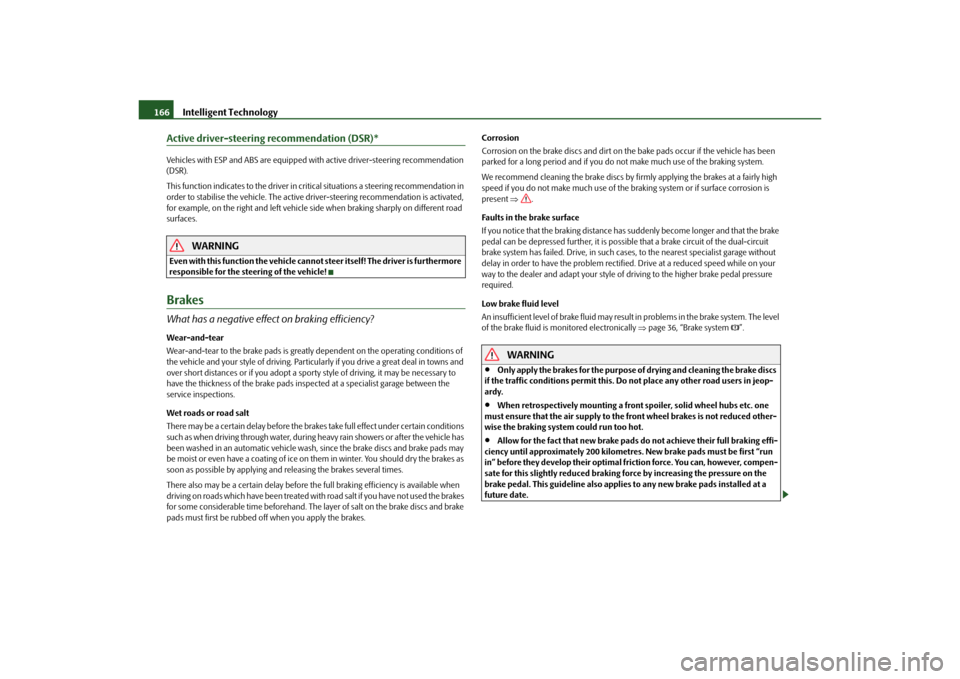
Intelligent Technology
166
Active driver-steering recommendation (DSR)*Vehicles with ESP and ABS are equipped with active driver-steering recommendation
(DSR).
This function indicates to the driver in critical situations a steering recommendation in
order to stabilise the vehicle. The active driver-steering recommendation is activated,
for example, on the right and left vehicle si de when braking sharply on different road
surfaces.
WARNING
Even with this function the vehicle canno t steer itself! The driver is furthermore
responsible for the steering of the vehicle!BrakesWhat has a negative effect on braking efficiency?Wear-and-tear
Wear-and-tear to the brake pads is greatly dependent on the operating conditions of
the vehicle and your style of driving. Particul arly if you drive a great deal in towns and
over short distances or if you adopt a sporty style of driving, it may be necessary to
have the thickness of the brake pads inspected at a specialist garage between the
service inspections.
Wet roads or road salt
There may be a certain delay before the brakes take full effect under certain conditions
such as when driving through water, during heavy rain showers or after the vehicle has
been washed in an automatic vehicle wash , since the brake discs and brake pads may
be moist or even have a coatin g of ice on them in winter. Yo u s h o u l d d r y t h e b r a k e s a s
soon as possible by applying and releasing the brakes several times.
There also may be a certain delay before the full braking efficiency is available when
driving on roads which have been treated with road salt if you have not used the brakes
for some considerable time beforehand. The layer of salt on the brake discs and brake
pads must first be rubbed off when you apply the brakes. Corrosion
Corrosion on the brake discs and dirt on the bake pads occur if
the vehicle has been
parked for a long period and if you do not make much use of the braking system.
We recommend cleaning the brake discs by firm ly applying the brakes at a fairly high
speed if you do not make much use of the braking system or if surface corrosion is
present .
Faults in the brake surface
If you notice that the braking distance has suddenly become longer and that the brake
pedal can be depressed further, it is possib le that a brake circuit of the dual-circuit
brake system has failed. Drive, in such cases, to the nearest specialist garage without
delay in order to have the problem rectifie d. Drive at a reduced speed while on your
way to the dealer and adapt your style of driving to the higher brake pedal pressure
required.
Low brake fluid level
An insufficient level of brake fluid may result in problems in the brake system. The level
of the brake fluid is monitored electronically page 36, “Brake system ”.
WARNING
Only apply the brakes for the purpose of drying and cleaning the brake discs
if the traffic conditions permit this. Do not place any other road users in jeop-
ardy.
When retrospectively mounting a front spoiler, solid wheel hubs etc. one
must ensure that the air supply to the front wheel brakes is not reduced other-
wise the braking system could run too hot.
Allow for the fact that new brake pads do not achieve their full braking effi-
ciency until approximately 200 kilometres. New brake pads must be first “run
in” before they develop their optimal fric tion force. You can, however, compen-
sate for this slightly reduced braking fo rce by increasing the pressure on the
brake pedal. This guideline also applie s to any new brake pads installed at a
future date.
s2ug.6.book Page 166 Friday, April 9, 2010 2:24 PM
Page 168 of 271
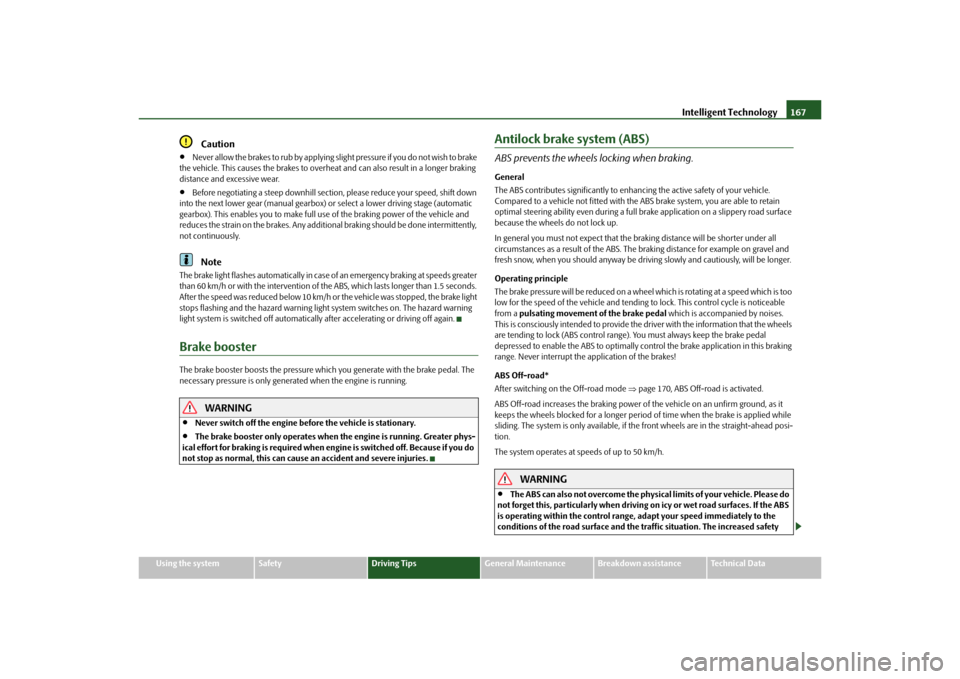
Intelligent Technology167
Using the system
Safety
Driving Tips
General Maintenance
Breakdown assistance
Technical Data
Caution
Never allow the brakes to rub by applying sl ight pressure if you do not wish to brake
the vehicle. This causes the br akes to overheat and can also result in a longer braking
distance and excessive wear.
Before negotiating a steep downhill section, please reduce your speed, shift down
into the next lower gear (manual gearbox) or select a lower driving stage (automatic
gearbox). This enables you to make full us e of the braking power of the vehicle and
reduces the strain on the brakes. Any additional braking should be done intermittently,
not continuously.Note
The brake light flashes automatically in case of an emergency braking at speeds greater
than 60 km/h or with the intervention of the ABS, which lasts longer than 1.5 seconds.
After the speed was reduced below 10 km/h or the vehicle was stopped, the brake light
stops flashing and the hazard warning light system switches on. The hazard warning
light system is switched off automatically after accelerating or driving off again.Brake boosterThe brake booster boosts the pressure which you generate with the brake pedal. The
necessary pressure is only genera ted when the engine is running.
WARNING
Never switch off the engine before the vehicle is stationary.
The brake booster only operates when the engine is running. Greater phys-
ical effort for braking is required when en gine is switched off. Because if you do
not stop as normal, this can cause an accident and severe injuries.
Antilock brake system (ABS)ABS prevents the wheels locking when braking.General
The ABS contributes significantly to enhanc ing the active safety of your vehicle.
Compared to a vehicle not fitted with the ABS brake system, you are able to retain
optimal steering ability even during a full br ake application on a slippery road surface
because the wheels do not lock up.
In general you must not expect that the braking distance will be shorter under all
circumstances as a result of the ABS. The braking distance for example on gravel and
fresh snow, when you should anyway be driv ing slowly and cautiously, will be longer.
Operating principle
The brake pressure will be reduced on a wheel which is rotating at a speed which is too
low for the speed of the vehicle and tending to lock. This control cycle is noticeable
from a pulsating movement of the brake pedal which is accompanied by noises.
This is consciously intended to provide the driver with the information that the wheels
are tending to lock (ABS control range). You must always keep the brake pedal
depressed to enable the ABS to optimally control the brake application in this braking
range. Never interrupt the application of the brakes!
ABS Off-road*
After switching on the Off-road mode page 170, ABS Off-road is activated.
ABS Off-road increases the braking power of the vehicle on an unfirm ground, as it
keeps the wheels blocked for a longer period of time when the brake is applied while
sliding. The system is only available, if the front wheels are in the straight-ahead posi-
tion.
The system operates at speeds of up to 50 km/h.
WARNING
The ABS can also not overcome the physical limits of your vehicle. Please do
not forget this, particularly when driving on icy or wet road surfaces. If the ABS
is operating within the control range, adapt your speed immediately to the
conditions of the road surface and the traffic situation. The increased safety
s2ug.6.book Page 167 Friday, April 9, 2010 2:24 PM
Page 169 of 271
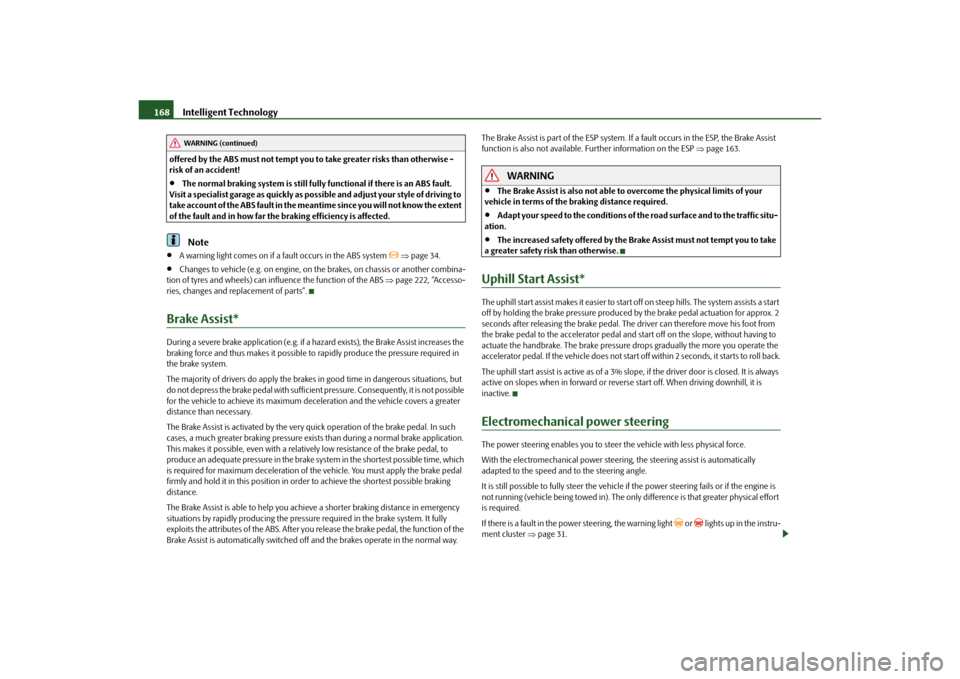
Intelligent Technology
168
offered by the ABS must not tempt you to take greater risks than otherwise -
risk of an accident!
The normal braking system is still fully functional if there is an ABS fault.
Visit a specialist garage as quickly as poss ible and adjust your style of driving to
take account of the ABS fault in the meantime since you will not know the extent
of the fault and in how far the braking efficiency is affected.Note
A warning light comes on if a fault occurs in the ABS system
page 34.
Changes to vehicle (e.g. on engine, on th e brakes, on chassis or another combina-
tion of tyres and wheels) can in fluence the function of the ABS page 222, “Accesso-
ries, changes and replacement of parts”.
Brake Assist*During a severe brake application (e.g. if a hazard exists), the Brake Assist increases the
braking force and thus makes it possible to rapidly produce the pressure required in
the brake system.
The majority of drivers do apply the brakes in good time in dangerous situations, but
do not depress the brake pedal with sufficient pressure. Consequently, it is not possible
for the vehicle to achieve its maximum deceleration and the vehicle covers a greater
distance than necessary.
The Brake Assist is activated by the very quick operation of the brake pedal. In such
cases, a much greater braking pressure exists than during a normal brake application.
This makes it possible, even with a relative ly low resistance of the brake pedal, to
produce an adequate pressure in the brake system in the shortest possible time, which
is required for maximum deceleration of th e vehicle. You must apply the brake pedal
firmly and hold it in this position in order to achieve the shortest possible braking
distance.
The Brake Assist is able to help you achieve a shorter braking distance in emergency
situations by rapidly producing the pressure required in the brake system. It fully
exploits the attributes of the ABS. After you release the brake pedal, the function of the
Brake Assist is automatically switched off and the brakes operate in the normal way. The Brake Assist is part of the ESP system. If a fault occurs in the ESP, the Brake Assist
function is also not available.
Further information on the ESP page 163.
WARNING
The Brake Assist is also not able to overcome the physical limits of your
vehicle in terms of the braking distance required.
Adapt your speed to the conditions of th e road surface and to the traffic situ-
ation.
The increased safety offered by the Brake Assist must not tempt you to take
a greater safety risk than otherwise.
Uphill Start Assist*The uphill start assist makes it easier to start off on steep hills. The system assists a start
off by holding the brake pressure produced by the brake pedal actuation for approx. 2
seconds after releasing the brake pedal. The driver can therefore move his foot from
the brake pedal to the accelerator pedal and start off on the slope, without having to
actuate the handbrake. The brake pressure drops gradually the more you operate the
accelerator pedal. If the vehicle does not start off within 2 seconds, it starts to roll back.
The uphill start assist is active as of a 3% slope, if the driver door is closed. It is always
active on slopes when in forward or reverse start off. When driving downhill, it is
inactive.Electromechanical power steeringThe power steering enables you to steer the vehicle with less physical force.
With the electromechanical power steering, the steering assist is automatically
adapted to the speed and to the steering angle.
It is still possible to fully steer the vehicle if the power steering fails or if the engine is
not running (vehicle being towed in). The only difference is that greater physical effort
is required.
If there is a fault in the power steering, the warning light
or lights up in the instru-
ment cluster page 31.
WARNING (continued)
s2ug.6.book Page 168 Friday, April 9, 2010 2:24 PM
Page 170 of 271
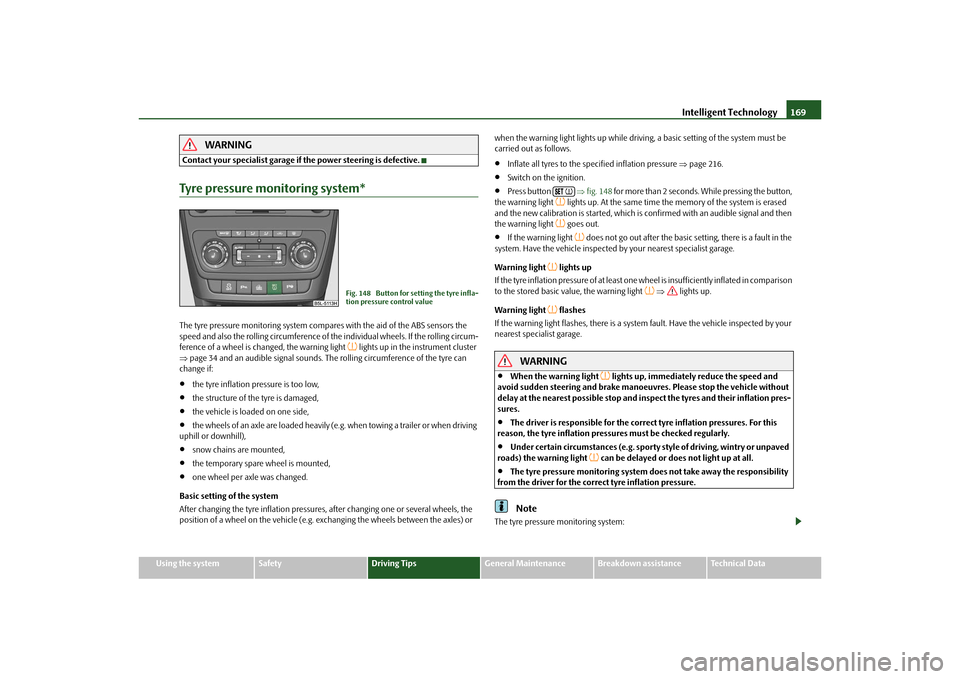
Intelligent Technology169
Using the system
Safety
Driving Tips
General Maintenance
Breakdown assistance
Technical Data
WARNING
Contact your specialist garage if the power steering is defective.Tyre pressure monitoring system*The tyre pressure monitoring system compares with the aid of the ABS sensors the
speed and also the rolling circumference of the individual wheels. If the rolling circum-
ference of a wheel is changed, the warning light
lights up in the instrument cluster
page 34 and an audible sign al sounds. The rolling circumference of the tyre can
change if:
the tyre inflation pressure is too low,
the structure of the tyre is damaged,
the vehicle is loaded on one side,
the wheels of an axle are loaded heavily (e.g. when towing a trailer or when driving
uphill or downhill),
snow chains are mounted,
the temporary spare wheel is mounted,
one wheel per axle was changed.
Basic setting of the system
After changing the tyre inflation pressures, after changing one or several wheels, the
position of a wheel on the vehicle (e.g. exch anging the wheels between the axles) or when the warning light lights up while drivin
g, a basic setting of the system must be
carried out as follows.
Inflate all tyres to the specified inflation pressure page 216.
Switch on the ignition.
Press button fig. 148 for more than 2 seconds. While pressing the button,
the warning light
lights up. At the same time the memory of the system is erased
and the new calibration is started, which is confirmed with an audible signal and then
the warning light goes out.
If the warning light
does not go out after the basic setting, there is a fault in the
system. Have the vehicle inspected by your nearest specialist garage.
Warning light
lights up
If the tyre inflation pressure of at least one wheel is insufficiently inflated in comparison
to the stored basic va lue, the warning light
lights up.
Warning light
flashes
If the warning light flashes, there is a system fault. Have the vehicle inspected by your
nearest specialist garage.
WARNING
When the warning light
lights up, immediately reduce the speed and
avoid sudden steering and brake manoeuvr es. Please stop the vehicle without
delay at the nearest possible stop and in spect the tyres and their inflation pres-
sures.
The driver is responsible for the correc t tyre inflation pressures. For this
reason, the tyre inflation pressures must be checked regularly.
Under certain circumstances (e.g. sporty style of driving, wintry or unpaved
roads) the warning light
can be delayed or does not light up at all.
The tyre pressure monitoring system do es not take away the responsibility
from the driver for the correct tyre inflation pressure.Note
The tyre pressure monitoring system:
Fig. 148 Button for setting the tyre infla-
tion pressure control value
s2ug.6.book Page 169 Friday, April 9, 2010 2:24 PM
Page 171 of 271

Intelligent Technology
170
does not replace the regular tyre inflatio n pressure control, because the system
cannot detect an even pressure loss;
cannot warn in case of very rapid tyre inflation pressure loss, e.g. in case of sudden
tyre damage. In this case carefully bring the vehicle to a standstill without sudden
steering movements and without sharp braking.
In order to ensure a proper functioning of the tyre inflation pressure-control
system, it is necessary to carry out the basic setting again every 10 000 km or 1x a
year.
Diesel particle filter* (diesel engine)In the diesel particle filter the resu lting soot particles are collected and
burnt during the combustion of diesel fuel.Code 7GG, 7MB or 7MG on the vehicle data sticker, see fig. 149 , indicates that your
vehicle is equipped with a diesel particle filter. The ve hicle data sticker is located on
the floor of the luggage compartment and is also stated in the Service schedule.
The diesel particle filter filters the soot particles completely from the exhaust. The soot
is collected in the diesel particle filter and burnt regularly. To assist this procedure, we
recommend not to drive regu larly over short distances.
If the diesel particle filter is clogged or there is a fault, it is indicated by the warning light
.
WARNING
The diesel particle filter achieves very high temp eratures. Therefore do not
park at points where the hot filter comes into direct contact with dry grass or
other combustible materials - risk of fire!
Never use additional underbody protection or corrosion-protection agents
for the exhaust pipes, catalytic converters, diesel particle filter or heat shields.
When the engine reaches its operating temperature, these substances might
ignite - risk of fire.Note
When using diesel fuel with high sulphur content the life of the diesel particle filter
is clearly reduced. A specialist garage will be able to tell you which countries use only
diesel fuel with high sulphur content.
Off-road*GeneralThe Off-road mode comprises functions which assist off-road driving.
The following functions are integrated in the Off-road mode:
Start-Off Assist page 171,
Downhill Drive Support page 171,
EDL Off-road page 164,
Fig. 149 Vehicle data sticker
Fig. 150 Off-road switch
s2ug.6.book Page 170 Friday, April 9, 2010 2:24 PM
Page 172 of 271
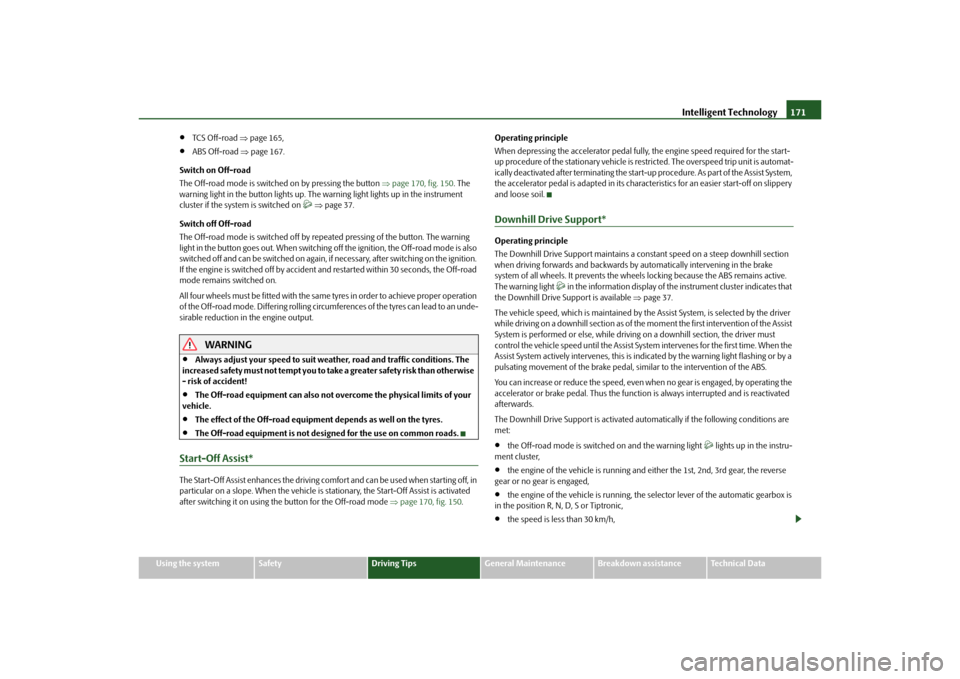
Intelligent Technology171
Using the system
Safety
Driving Tips
General Maintenance
Breakdown assistance
Technical Data
TCS Off-road page 165,
ABS Off-road page 167.
Switch on Off-road
The Off-road mode is switched on by pressing the button page 170, fig. 150 . The
warning light in the button lights up. The warning light lights up in the instrument
cluster if the system is switched on
page 37.
Switch off Off-road
The Off-road mode is switched off by repe ated pressing of the button. The warning
light in the button goes out. When switching off the ignition, the Off-road mode is also
switched off and can be switched on again, if necessary, after switching on the ignition.
If the engine is switched off by accident an d restarted within 30 seconds, the Off-road
mode remains switched on.
All four wheels must be fitted with the same tyres in order to achieve proper operation
of the Off-road mode. Differing rolling circum ferences of the tyres can lead to an unde-
sirable reduction in the engine output.
WARNING
Always adjust your speed to suit weat her, road and traffic conditions. The
increased safety must not tempt you to take a greater safety risk than otherwise
- risk of accident!
The Off-road equipment can also not overcome the physical limits of your
vehicle.
The effect of the Off-road equipment depends as well on the tyres.
The Off-road equipment is not designed for the use on common roads.
Start-Off Assist*The Start-Off Assist enhances the driving comfort and can be used when starting off, in
particular on a slope. When the vehicle is stationary, the Start-Off Assist is activated
after switching it on using the button for the Off-road mode page 170, fig. 150 .Operating principle
When depressing the accelerator pedal fully, the engine speed required for the start-
up procedure of the stationary vehicle is restricted. The overspeed trip unit is automat-
ically deactivated after terminating the start-up procedure. As part of the Assist System,
the accelerator pedal is adapted in its characteristics for an easier start-off on slippery
and loose soil.
Downhill Drive Support*Operating principle
The Downhill Drive Support maintains a cons
tant speed on a steep downhill section
when driving forwards and backwards by automatically intervening in the brake
system of all wheels. It prevents the wheels locking because the ABS remains active.
The warning light
in the information display of the instrument cluster indicates that
the Downhill Drive Support is available page 37.
The vehicle speed, which is maintained by the Assist System, is selected by the driver
while driving on a downhill section as of the moment the first intervention of the Assist
System is performed or else, while driving on a downhill section, the driver must
control the vehicle speed until the Assist System intervenes for the first time. When the
Assist System actively intervenes, this is indicated by the warning light flashing or by a
pulsating movement of the brake pedal, similar to the intervention of the ABS.
You can increase or reduce the speed, even when no gear is engaged, by operating the
accelerator or brake pedal. Thus the function is always interrupted and is reactivated
afterwards.
The Downhill Drive Support is activated auto matically if the following conditions are
met:
the Off-road mode is switched on and the warning light
lights up in the instru-
ment cluster,
the engine of the vehicle is running and either the 1st, 2nd, 3rd gear, the reverse
gear or no gear is engaged,
the engine of the vehicle is running, the selector lever of the automatic gearbox is
in the position R, N, D, S or Tiptronic,
the speed is less than 30 km/h,
s2ug.6.book Page 171 Friday, April 9, 2010 2:24 PM
Page 183 of 271
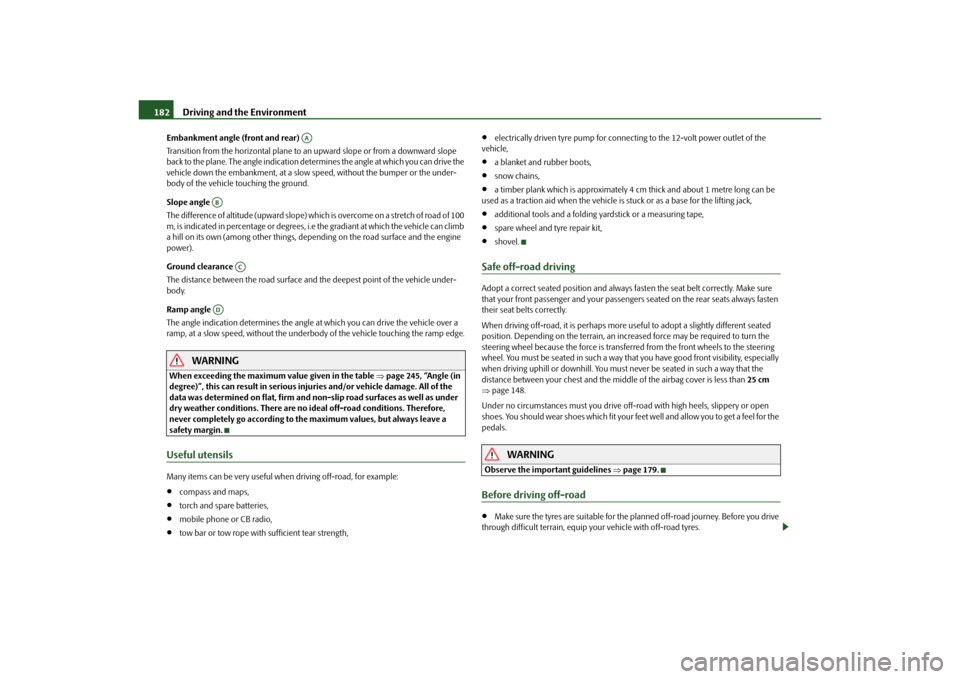
Driving and the Environment
182
Embankment angle (front and rear)
Transition from the horizontal plane to an upward slope or from a downward slope
back to the plane. The angle indication determines the angle at which you can drive the
vehicle down the embankment, at a slow speed, without the bumper or the under-
body of the vehicle touching the ground.
Slope angle
The difference of altitude (upward slope) which is overcome on a stretch of road of 100
m, is indicated in percentage or degrees, i. e the gradiant at which the vehicle can climb
a hill on its own (among other things, depe nding on the road surface and the engine
power).
Ground clearance
The distance between the road surface and the deepest point of the vehicle under-
body.
Ramp angle
The angle indication determines the angle at which you can drive the vehicle over a
ramp, at a slow speed, without the underbody of the vehicle touching the ramp edge.
WARNING
When exceeding the maximum value given in the table page 245, “Angle (in
degree)”, this can result in serious inju ries and/or vehicle damage. All of the
data was determined on flat, firm and no n-slip road surfaces as well as under
dry weather conditions. There are no id eal off-road conditions. Therefore,
never completely go according to the maximum values, but always leave a
safety margin.Useful utensilsMany items can be very useful wh en driving off-road, for example:
compass and maps,
torch and spare batteries,
mobile phone or CB radio,
tow bar or tow rope with sufficient tear strength,
electrically driven tyre pump for connect ing to the 12-volt power outlet of the
vehicle,
a blanket and rubber boots,
snow chains,
a timber plank which is approximately 4 cm thick and about 1 metre long can be
used as a traction aid when the vehicle is stuck or as a base for the lifting jack,
additional tools and a folding yardstick or a measuring tape,
spare wheel and tyre repair kit,
shovel.
Safe off-road drivingAdopt a correct seated position and always fa sten the seat belt correctly. Make sure
that your front passenger and your passengers seated on the rear seats always fasten
their seat belts correctly.
When driving off-road, it is perhaps more useful to adopt a slightly different seated
position. Depending on the terrain, an incr eased force may be required to turn the
steering wheel because the force is transferred from the front wheels to the steering
wheel. You must be seated in such a way that you have good front visibility, especially
when driving uphill or downhill. You must never be seated in such a way that the
distance between your chest and the midd le of the airbag cover is less than 25 cm
page 148.
Under no circumstances must you drive off-ro ad with high heels, slippery or open
shoes. You should wear shoes which fit your feet well and allow you to get a feel for the
pedals.
WARNING
Observe the important guidelines page 179.Before driving off-road
Make sure the tyres are suitable for the pl anned off-road journey. Be fore you dri ve
through difficult terrain, equip yo ur vehicle with off-road tyres.
AA
AB
AC
AD
s2ug.6.book Page 182 Friday, April 9, 2010 2:24 PM
Page 187 of 271
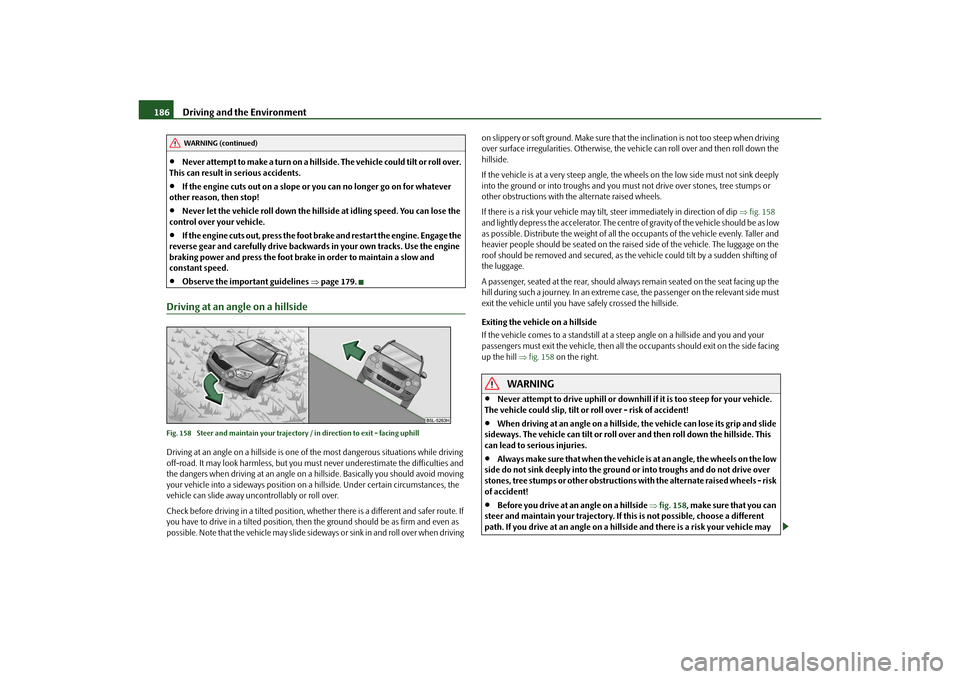
Driving and the Environment
186
Never attempt to make a turn on a hillside. The vehicle could tilt or roll over.
This can result in serious accidents.
If the engine cuts out on a slope or you can no longer go on for whatever
other reason, then stop!
Never let the vehicle roll down the hill side at idling speed. You can lose the
control over your vehicle.
If the engine cuts out, press the foot brake and restart the engine. Engage the
reverse gear and carefully drive backward s in your own tracks. Use the engine
braking power and press the foot brake in order to maintain a slow and
constant speed.
Observe the important guidelines page 179.
Driving at an angle on a hillsideFig. 158 Steer and maintain your trajectory / in direction to exit - facing uphillDriving at an angle on a hillside is one of the most dangerous situations while driving
off-road. It may look harmless, but you must never underestimate the difficulties and
the dangers when driving at an angle on a hillside. Basically you should avoid moving
your vehicle into a sideways position on a hillside. Under certain circumstances, the
vehicle can slide away uncon trollably or roll over.
Check before driving in a tilted position, whether there is a different and safer route. If
you have to drive in a tilted position, then the ground should be as firm and even as
possible. Note that the vehicle may slide sideways or sink in and roll over when driving on slippery or soft ground. Make sure that
the inclination is not too steep when driving
over surface irregularities. Otherwise, the vehicle can roll over and then roll down the
hillside.
If the vehicle is at a very steep angle, the wheels on the low side must not sink deeply
into the ground or into troughs and you mu st not drive over stones, tree stumps or
other obstructions with the alternate raised wheels.
If there is a risk your ve hicle may tilt, steer immedi ately in direction of dip fig. 158
and lightly depress the accelerator. The centre of gravity of the vehicle should be as low
as possible. Distribute the weight of all the occupants of the vehicle evenly. Taller and
heavier people should be seated on the rais ed side of the vehicle. The luggage on the
roof should be removed and secured, as the vehicle could tilt by a sudden shifting of
the luggage.
A passenger, seated at the rear, should always remain seated on the seat facing up the
hill during such a journey. In an extreme case , the passenger on the relevant side must
exit the vehicle until you have safely crossed the hillside.
Exiting the vehicle on a hillside
If the vehicle comes to a standstill at a st eep angle on a hillside and you and your
passengers must exit the vehicle, then all th e occupants should exit on the side facing
up the hill fig. 158 on the right.
WARNING
Never attempt to drive uphill or downhill if it is too steep for your vehicle.
The vehicle could slip, tilt or roll over - risk of accident!
When driving at an angle on a hillside, the vehicle can lose its grip and slide
sideways. The vehicle can tilt or roll over and then roll down the hillside. This
can lead to serious injuries.
Always make sure that when the vehicle is at an angle, the wheels on the low
side do not sink deeply into the ground or into troughs and do not drive over
stones, tree stumps or other obstructions with the alternate raised wheels - risk
of accident!
Before you drive at an angle on a hillside fig. 158 , make sure that you can
steer and maintain your trajectory. If this is not possible, choose a different
path. If you drive at an an gle on a hillside and there is a risk your vehicle may
WARNING (continued)
s2ug.6.book Page 186 Friday, April 9, 2010 2:24 PM